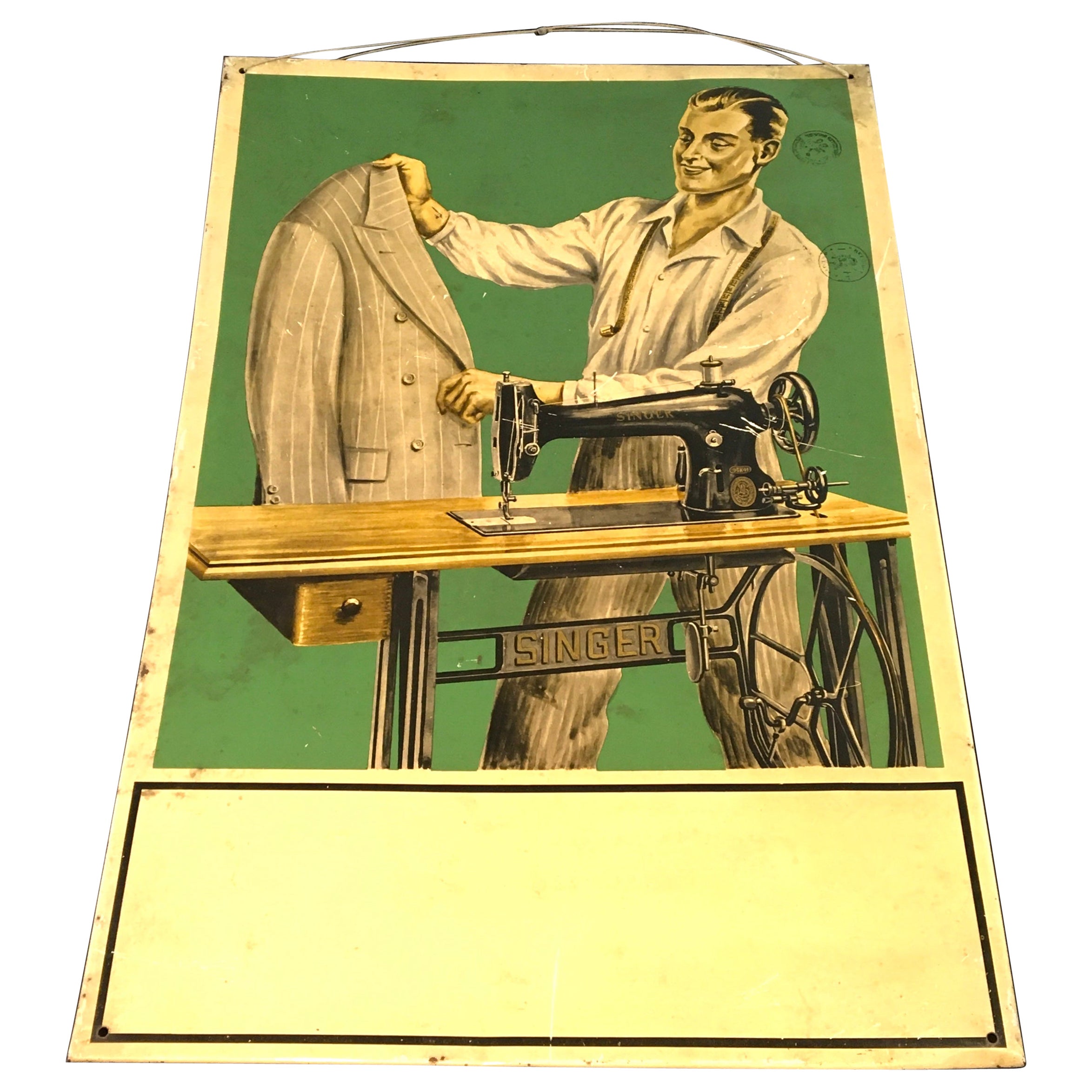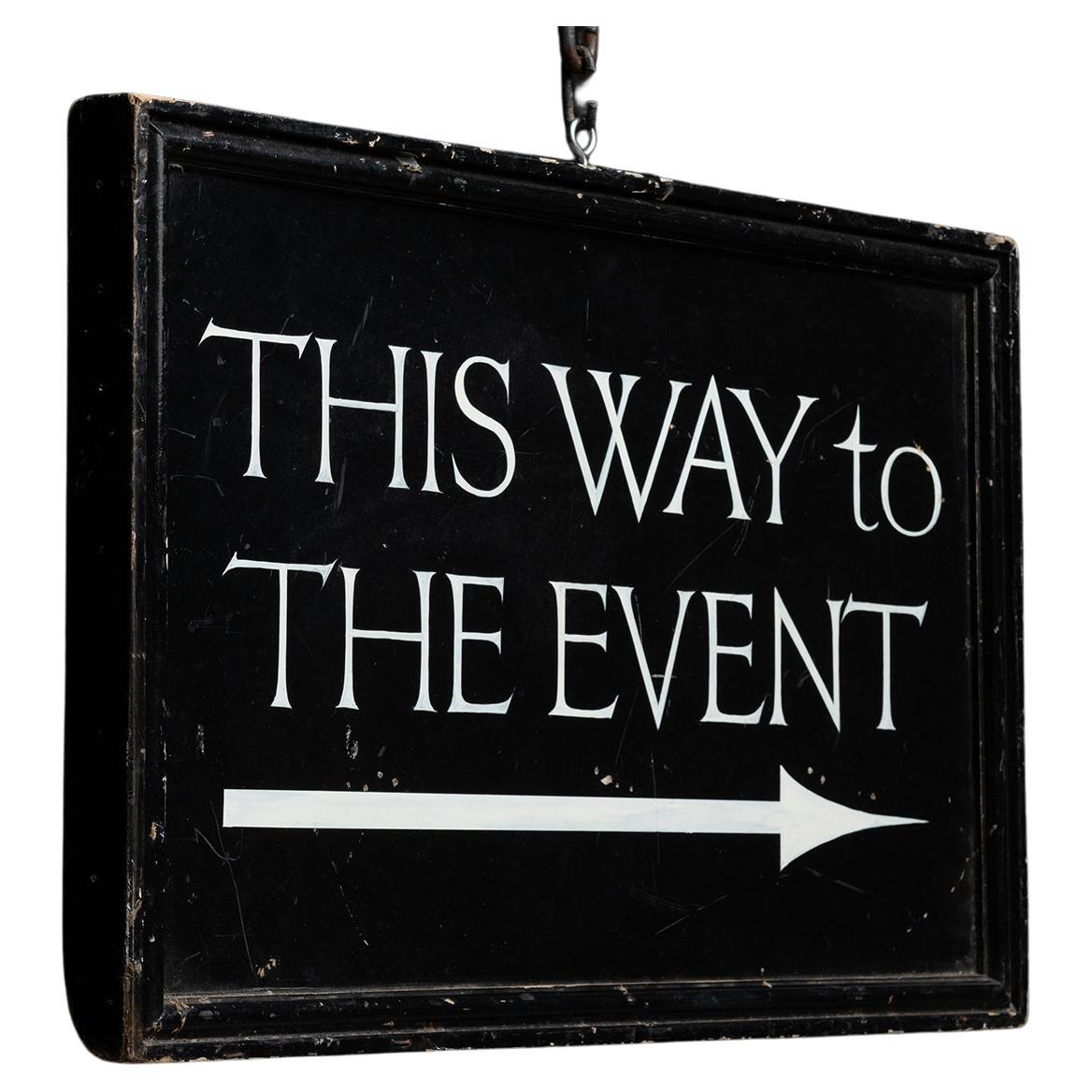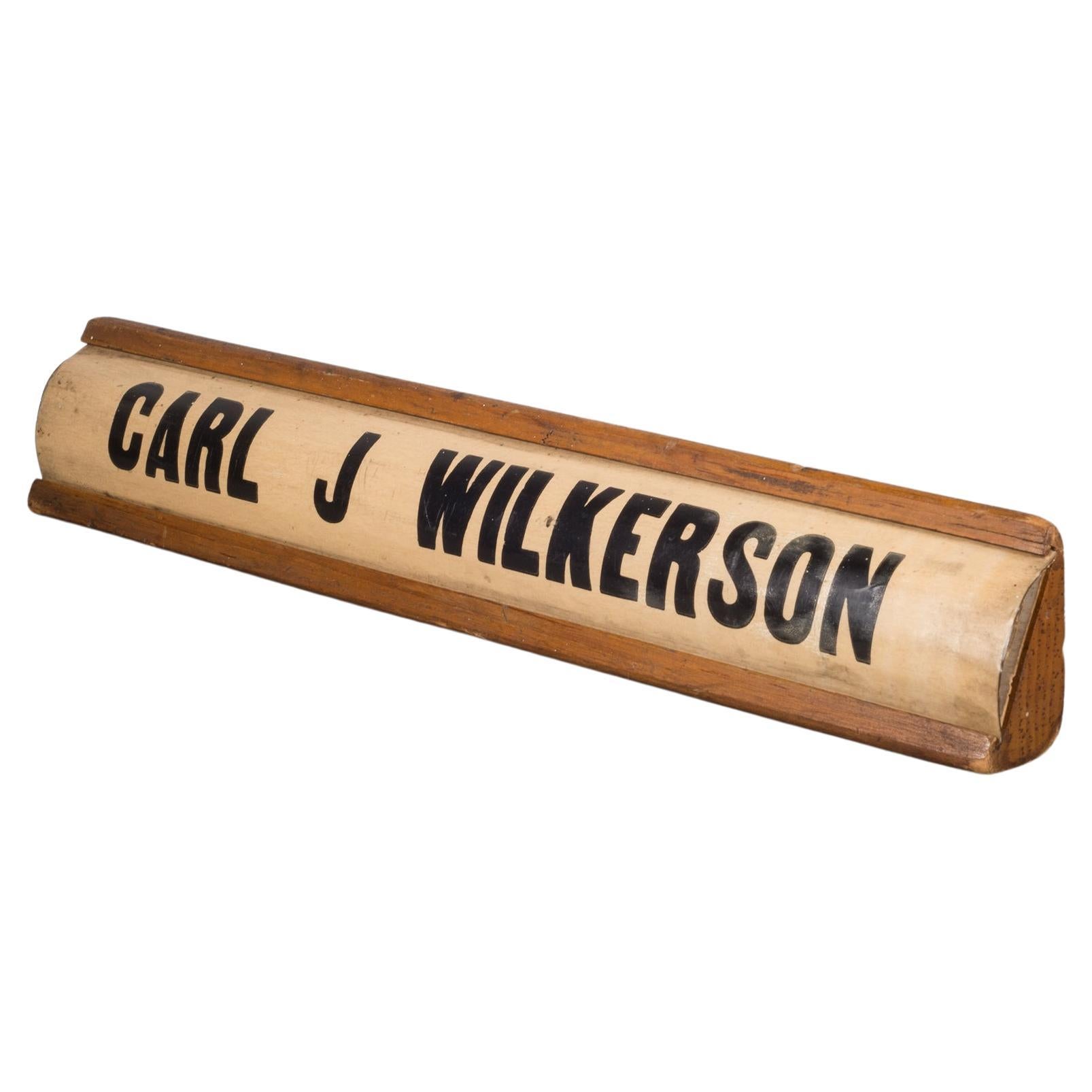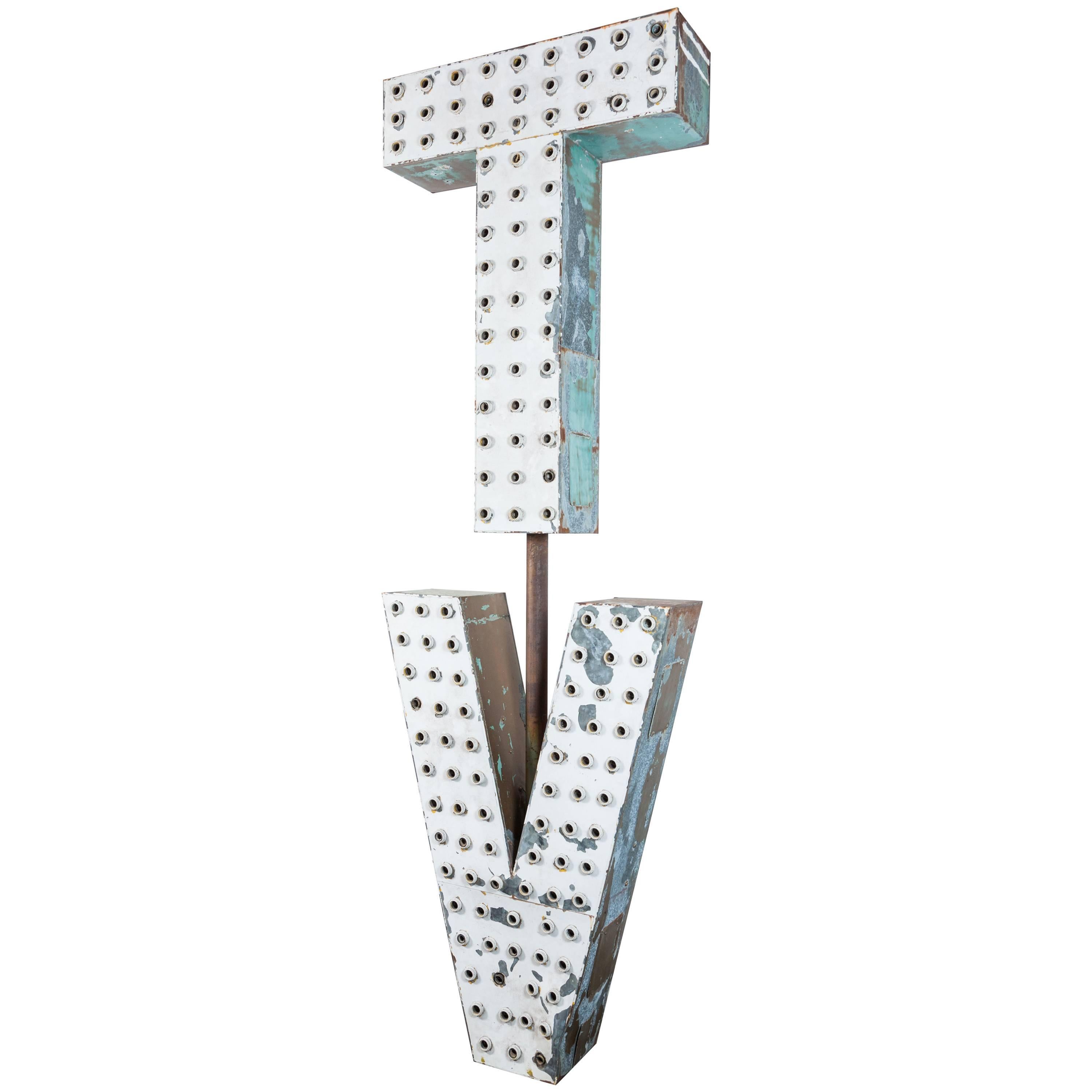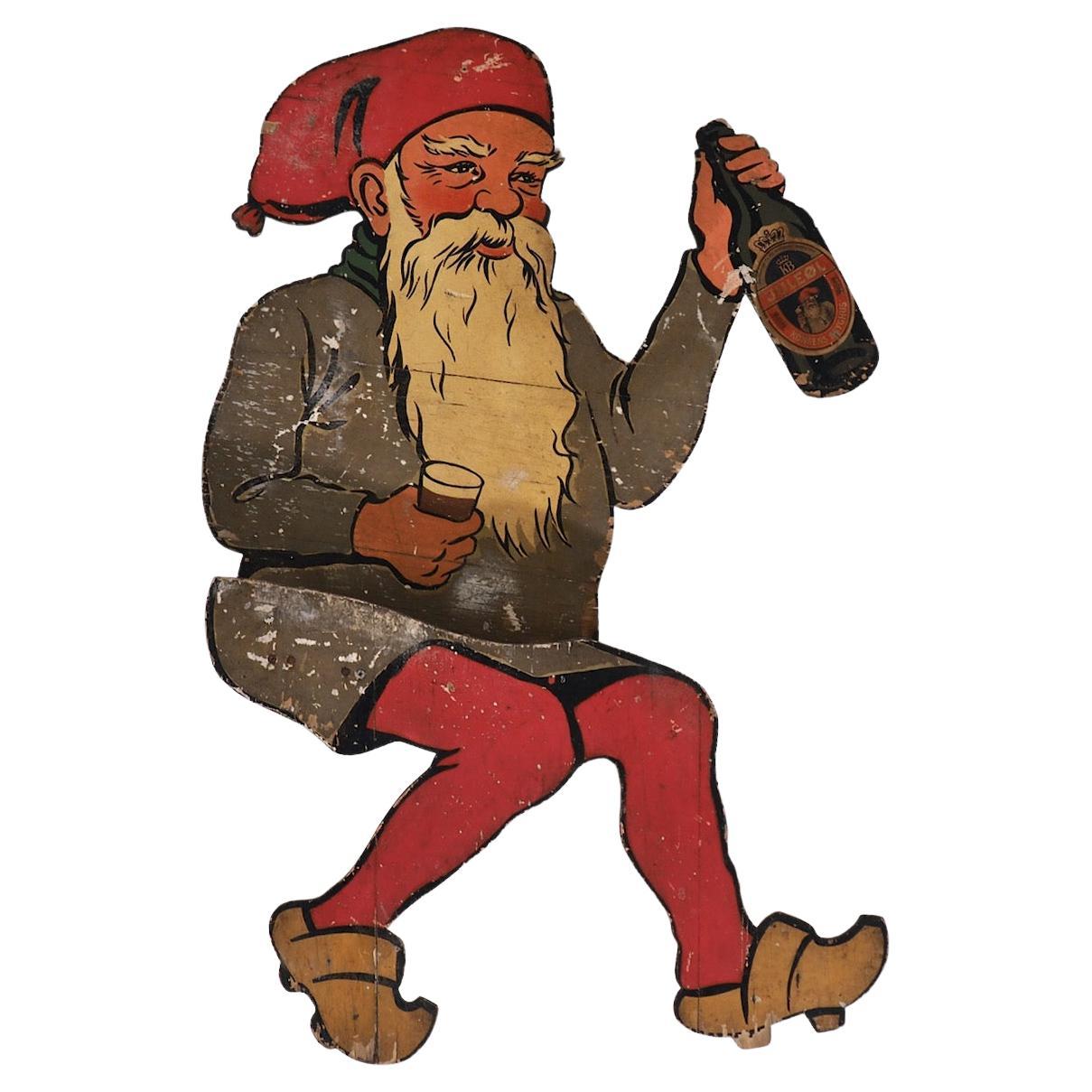Items Similar to "B. Briscoe, Tailor" Sign with a Backwards S, circa 1810-1850
Want more images or videos?
Request additional images or videos from the seller
1 of 6
"B. Briscoe, Tailor" Sign with a Backwards S, circa 1810-1850
About the Item
Early American trade sign: “B. BRISCOE, TAILOR,” circa 1810-1850, with a backwards “S” and extraordinary surface
Early, painted, American trade sign, made of pine, with a molded edge, applied with “T”-head nails. In very dark green, almost black, rendered on an oyster white ground, the stylized and whimsical lettering reads: “B. Briscoe; Tailor” with a backwards “S.” I can’t decide if I like this feature better, or the painted surface, which is simply exceptional.
This is a second surface over the name of a previous tailor, “J. Bicknell.” To make the alteration, the first “B” was changed to a “J.” The second “B” was left in place. The “I” in Bicknell was turned into an “R.” The “ISCO” was painted over “CKN,” and the “E” was kept. The two “L’s” were painted over. “Tailor” was left in place. I estimate that the sign was constructed sometime between 1810 and the 1820’s then repainted between 1830 and the 1850’s, with the name altered to reflect the new owner.
The sign came out of the Lebanon, NY (Madison County, upstate, between Syracuse and Albany) area in the early 2,000's, and I suspect originated somewhere in the greater region.
Condition: Extremely light, matt varnish applied to consolidate and preserve the original surface.
- Dimensions:Height: 16 in (40.64 cm)Width: 66.75 in (169.55 cm)Depth: 1.75 in (4.45 cm)
- Materials and Techniques:
- Place of Origin:
- Period:
- Date of Manufacture:1810-1850
- Condition:See Item Description.
- Seller Location:York County, PA
- Reference Number:
About the Seller
5.0
Recognized Seller
These prestigious sellers are industry leaders and represent the highest echelon for item quality and design.
Established in 1991
1stDibs seller since 2008
61 sales on 1stDibs
Typical response time: 10 hours
- ShippingRetrieving quote...Ships From: York County, PA
- Return PolicyThis item cannot be returned.
More From This SellerView All
- George Washington Painting, Oil on Canvas, ca 1850Located in York County, PAPainting of George Washington in oil on canvas, an early example, rendered circa 1850, a very pleasing and well-executed copy of Gilbert ...Category
Antique 1850s American Paintings
MaterialsCanvas
- Green Painted Pennsylvania Hanging Pie Safe, ca 1850-1880Located in York County, PAPennsylvania hanging pie safe, in first surface green paint, with circular medallion and opposing fan decoration, circa 1850-1880 Pennsylvania hang...Category
Antique Mid-19th Century American Painted Furniture
MaterialsWood
- Pennsylvania Backgammon Board, Signed "Wise"Located in York County, PAPENNSYLVANIA BACKGAMMON BOARD, SIGNED "WISE" WITH IMAGES OF A WAGON WHEEL AND A STAR OF DAVID, 1850-1880 Found near the town of Milford, in the northeast corner of Pennsylvania, is...Category
Antique 19th Century American Game Boards
MaterialsWood
- Hand-Pained Banner with the Seal of the State of Mississippi, circa 1872Located in York County, PAUnique, hand-painted banner with the seal of the state of mississippi, likely having represented delegates from that state at the 1872 republican or dem...Category
Antique 1870s American Political and Patriotic Memorabilia
MaterialsCotton
- Hand-Sewn 13 Star American Flag, Signed Grunfild, ca 1861-1877Located in York County, PAENTIRELY HAND-SEWN ANTIQUE AMERICAN FLAG OF THE CIVIL WAR ERA, WITH 13 SINGLE-APPLIQUÉD STARS IN A 3-2-3-2-3 CONFIGURATION, IN A GREAT, SMALL SCALE AMONG ITS COUNTERPARTS, PROBABLY MADE IN NEW YORK CITY, SIGNED “GRÜNFILD” 13 star flags have been flown throughout our nation’s history for a variety of purposes. They were hoisted at patriotic events, including Lafayette’s final visit in 1824-25, the celebration of the centennial of American independence in 1876, and the sesquicentennial in 1926. They were displayed during the Civil War, to reference past struggles for American liberty and victory over oppression, and were used by 19th century politicians while campaigning for the same reason. As the number of stars grew with the addition of new states, it became more and more difficult to fit their full complement on a small flag. The stars would, by necessity, have to become smaller, which made it more and more difficult to view them from a distance as individual objects. The fear was that too many of them close together would become as one white mass and distort the ability to identify American ships on the open seas. Keeping the count low allowed for better visibility. For this reason the U.S. Navy flew 13 star flags on small boats. Some private ship owners mirrored this practice and flew 13 star flags during the same period as the Navy. Flag experts disagree about precisely when the Navy began to revert to 13 stars and other low counts. Some feel that the use of 13 star flags never stopped, which seems to be supported by depictions of ships in period artwork. This was, of course, the original number of stars on the first American national flag, by way of the First Flag Act of 1777, and equal to the number of original colonies that became states. Since there was no official star configuration until the 20th century (1912 specifically, beginning with the 48 star count), the stars on 13 star flags may appear in any one of a host of configurations. Made during the Civil War era, or shortly thereafter, the stars of this particular 13 star flag are arranged in a 3-2-3-2-3 pattern of lineal rows. This configuration appears to have been adopted by the Navy sometime toward war’s end, probably between 1864 and 1865. Afterwards it becomes the most common design across all known styles, for the balance of the 19th century through the first quarter of the 20th. Entirely hand-sewn, the stripes and canton of the flag are made of wool bunting. Note in particular the square profile of the canton, which makes it visually different from modern flags. The stars are made of cotton and are single-appliquéd. This means that they were applied to one side of the canton, then the blue fabric was cut from behind each star, folded over, and under-hemmed, so that one star could be viewed on both sides. I always find single-appliquéd stars more interesting, not only because they are evidence of a more difficult level of seam-work and stitching, but also because they are more visually intriguing. The two visible rows of hand-stitching emphasize their hand-sewn construction. This is one reason why single-appliquéd stars appeal to connoisseurs of early American textiles. While some flag enthusiasts have pointed to this as a means of conserving fabric, not having to cut and sew another star to the opposite side, others suggest that the real purpose was to make the flag lighter in weight. I believe it to have been a byproduct of both objectives. A length of faded, red, herringbone, twill cotton tape was stitched along the hoist end for reinforcement, in lieu of a more formal binding. To this, six lengths of cotton knit shoelace were added (one now absent) as a means of affixing the flag to a staff. This is generally the accepted method for a flag that is to be hand-carried. The cloth tape and ties both add substantially to the flag’s visual presentation. The name “Grünfild” was at some point hand-inscribed beneath the canton. It was common to mark flags in this fashion, during the 19th and early 20th centuries, to indicate ownership. An unusual name in America at this time, I believe that this likely belonged to the only man by this name that is recording as having served during the Civil War. Born around 1843, Morris Grünfild [a.k.a. Grünfield / Greenfield / Grünfildt] emigrated to the United States from Eastern Europe in 1854. A merchant tailor, who I believe may have been of Russian Jewish descent, he records himself as having been born in “Poland / Rus,” but may have moved to Austria in the interim, before traveling to the States. In May of 1861, Grünfild enlisted with the 31st New York Volunteer Infantry, at the rank of Private, in New York City, and was assigned to “C” Company. He served two years, mustering out in New York on June 4th, 1863. Around 1877, Grünfild joined Frank Head Post #16 of the New York State Grand Army of the Republic. The GAR was the primary veteran’s organization for the Union Army. He married a Russian woman from Philadelphia, had many children, and continued to work as a tailor into the 20th century, possibly selling both his services and clothes. Presuming that it was this Morris Grünfild who owned and marked the flag, it is hard to be sure just how he came into possession of it. The construction is actually typical of flags produced in New York, during this time frame and after, by the Annin Company. Known for single-appliqued stars, and for hand-sewing the stripes of smaller flags in particular, as well as for simply producing more, small, sewn flags than their competitors, the flag closely approximates signed, Annin-made examples that I have previously owned. It may, of course, be that Grünfild acquired the necessary bunting at the wharf and sewed the flag in the same fashion as Annin, but I don’t think so. I do, however, believe that it was he who added the herringbone tape and shoelace ties to a flag probably of Annin manufacture. It’s possible that the 31st NY Regiment used the flag as a flank marker or as camp colors. Though a little large in scale for either when compared to military regulations, the flag is small enough to have served effectively in either function. This unit appears not to have turned any colors in to the state at the war’s end, so likely they were taken home. The role that Grünfild played as a private in C Company is unknown. As a tailor, it’s conceivable that he may have played a role in the care or upkeep of flags, but no further information is available. The 31st NY was a very active unit. Recruited from Williamsburg (just over the Brooklyn Bridge) and Manhattan, it had several nicknames, including the “Montezuma Regiment,” “Baxter Light...Category
Antique Late 19th Century American Political and Patriotic Memorabilia
MaterialsCotton
- Horse Head Trade Sign, Last Quarter of the 19th CenturyLocated in York County, PAAn exceptional, painted American trade sign made from carved wood in the full-bodied form of a race horse’s head. Wonderful movement, tremendous f...Category
Antique 19th Century American Folk Art Sculptures
MaterialsWood
You May Also Like
- Singer Sign with Tailor and Singer Sewing Machine, 1930sLocated in Antwerp, BEVintage Singer sign. A 1930s tin advertising sign for Singer Sewing and Embroidery Machines. An antique sign with a design of a tailor behind his Singer Sewing Machine...Category
Mid-20th Century Belgian Art Deco Signs
MaterialsTin
- Double Sided Sign, circa 1950Located in Culver City, CADouble Sided Sign England circa 1950 Hand painted sign with ebonised frame. 25.5”w x 1.75”d x 16.5”hCategory
Vintage 1950s English Modern Signs
MaterialsWood
- Vintage Desk Sign, circa 1944Located in San Francisco, CAAbout An original wooden desk sign for Carl J. Wilkerson from Fort Knox, Kentucky. His years of employment are written on the back as well as the signatu...Category
Early 20th Century Signs
MaterialsWood, Plastic, Paper
- Industrial Enamel Telephone Sign, circa 1950sLocated in Faversham, GBOriginal industrial enamel telephone sign in wonderful condition. Sitting atop its two original legs. Most likely used in a factory or possibly a mine. ...Category
20th Century British Edwardian Signs
MaterialsEnamel, Metal
- Magnavox Television Factory TV Sign, circa 1950sLocated in Santa Monica, CAIncredible giant TV sign that graced the circa 1950s . Magnavox TV factory in Utah. Just under 11 feet tall. Mounted on original heavy iron pole. Original whit...Category
Vintage 1950s American Steampunk Signs
MaterialsIron, Sheet Metal
- Commercial Sign of Santa, circa 100 YearsLocated in Aalsgaarde, DKWooden commercial sign of santa by the famous beer maker Tuborg, circa 100 years old.Category
20th Century Signs
MaterialsWood
